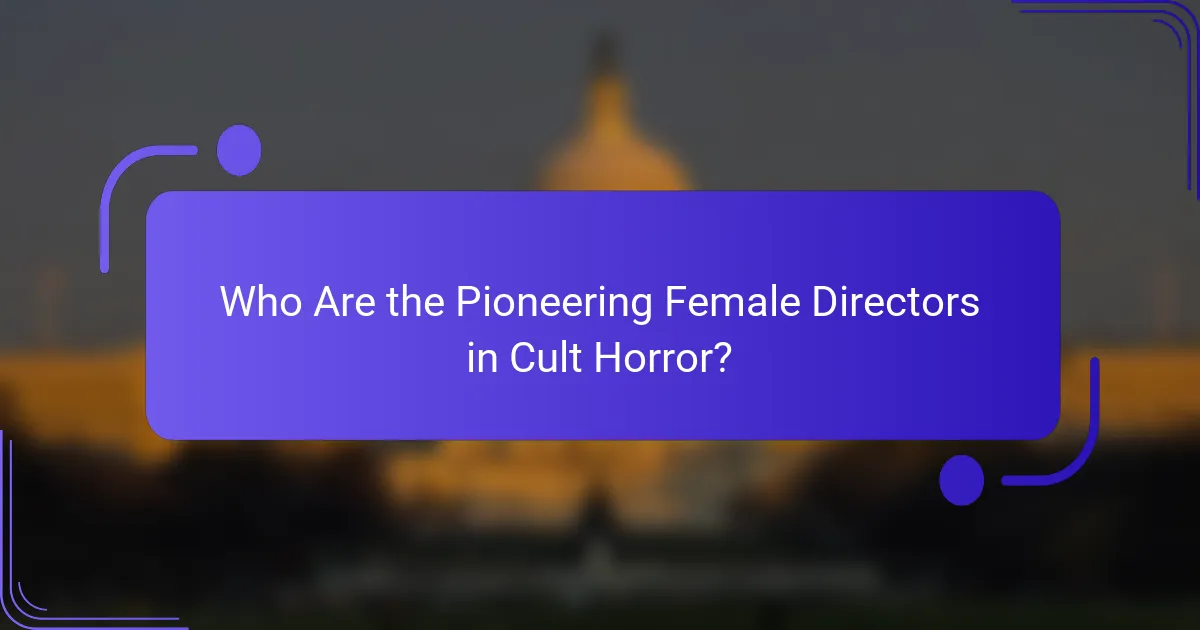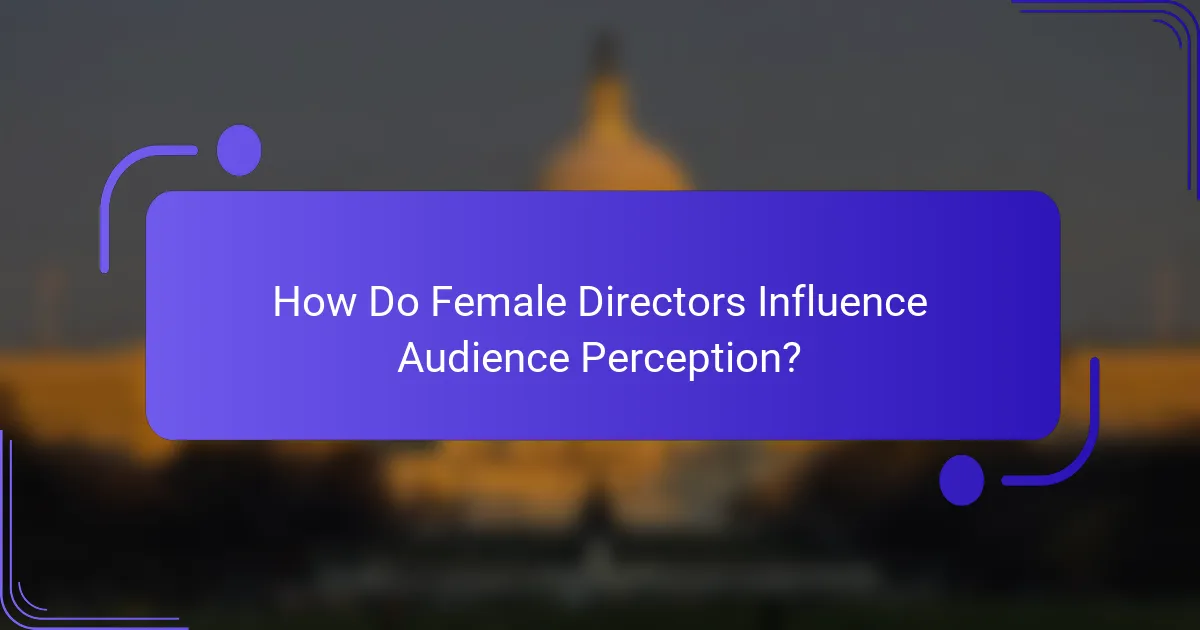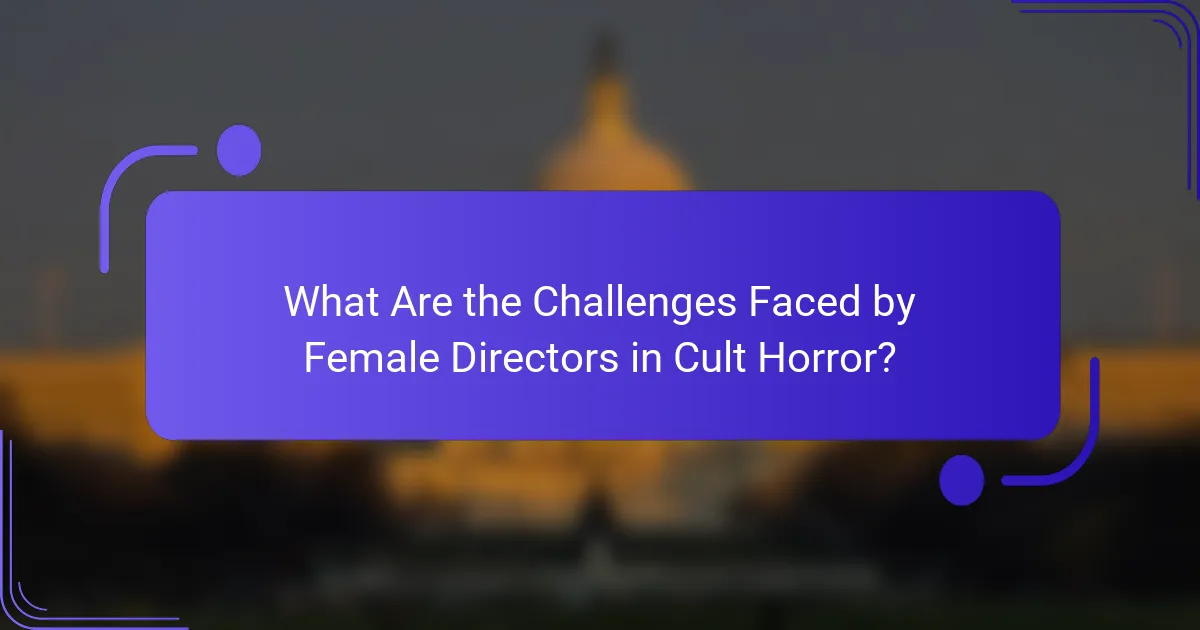Female directors are reshaping the cult horror genre by bringing unique visions and innovative storytelling techniques that challenge traditional narratives. Their work often explores themes of identity and societal norms, enriching the cinematic landscape with diverse perspectives. By emphasizing female identity and showcasing varied viewpoints, these pioneers are redefining horror and resonating with a broader audience.

How Are Female Directors Shaping Cult Horror?
Female directors are significantly influencing the cult horror genre by introducing fresh perspectives and innovative approaches. Their contributions often challenge traditional narratives and aesthetics, creating a richer and more diverse cinematic landscape.
You can learn more in iconic directors of cult horror.
Innovative storytelling techniques
Female directors often employ unconventional storytelling methods that subvert audience expectations. They may use nonlinear narratives, unreliable narrators, or intertwine personal experiences with genre tropes to create deeper emotional connections.
For example, films like “The Babadook” by Jennifer Kent utilize psychological elements to explore themes of grief and motherhood, transforming a typical horror story into a profound exploration of human emotion.
Unique visual styles
Many female directors bring distinct visual aesthetics to cult horror, utilizing color palettes, framing, and cinematography that reflect their unique visions. This can result in visually striking films that stand out in the genre.
Directors such as Karyn Kusama in “Jennifer’s Body” use vibrant colors and creative camera angles to enhance the narrative and evoke specific emotions, setting their work apart from traditional horror films.
Challenging genre norms
Female directors frequently challenge established genre norms, pushing boundaries regarding themes, character development, and representation. They often focus on female protagonists who defy stereotypes, offering more complex portrayals of women in horror.
Films like “A Girl Walks Home Alone at Night” by Ana Lily Amirpour blend horror with social commentary, addressing issues like gender and cultural identity while subverting typical horror conventions.

Who Are the Pioneering Female Directors in Cult Horror?
Pioneering female directors in cult horror are filmmakers who have significantly influenced the genre through their unique perspectives and storytelling techniques. These directors challenge conventions, often exploring themes of identity, societal norms, and the human psyche, contributing to a richer, more diverse cinematic landscape.
Mary Harron
Mary Harron is best known for her adaptation of Bret Easton Ellis’s novel “American Psycho,” which has become a cult classic. Her work often delves into themes of morality and identity, using dark humor to critique societal expectations.
Harron’s films frequently feature strong female characters and complex narratives, making her a significant figure in the horror genre. Her ability to blend horror with social commentary sets her apart as a director who challenges traditional storytelling.
Jennifer Kent
Jennifer Kent gained recognition for her debut feature “The Babadook,” which explores grief and motherhood through a horror lens. The film’s psychological depth and emotional resonance have earned it critical acclaim and a dedicated following.
Kent’s approach to horror emphasizes character development and emotional stakes, often blurring the lines between reality and psychological terror. Her work encourages viewers to confront their fears and vulnerabilities, making her contributions to cult horror both impactful and thought-provoking.
Julia Ducournau
Julia Ducournau made waves in the horror community with her film “Raw,” which examines themes of cannibalism and self-discovery. Her unique blend of body horror and coming-of-age narrative has garnered international attention and praise.
Ducournau’s films often challenge societal norms surrounding femininity and sexuality, pushing boundaries in the horror genre. Her bold storytelling and innovative visuals have established her as a leading voice in contemporary cult horror, inspiring a new generation of filmmakers.

What Unique Contributions Do Female Directors Bring to Cult Horror?
Female directors introduce distinctive perspectives and themes to cult horror, often emphasizing female identity, challenging traditional tropes, and showcasing diverse viewpoints. Their contributions enrich the genre, creating narratives that resonate with a broader audience and redefine horror storytelling.
Exploration of female identity
Female directors often delve into the complexities of female identity, portraying characters that reflect real-life struggles and experiences. This exploration can manifest through themes of empowerment, vulnerability, and resilience, allowing audiences to connect with the characters on a deeper level.
For instance, films like “The Babadook” and “Raw” highlight the psychological and emotional challenges faced by women, using horror as a lens to examine motherhood, trauma, and self-acceptance. Such narratives not only entertain but also provoke thought and discussion about women’s roles in society.
Subversion of traditional tropes
Many female directors actively subvert conventional horror tropes, challenging the stereotypical portrayals of women as victims or passive characters. By flipping these narratives, they create strong, complex female protagonists who drive the story forward.
Examples include “A Girl Walks Home Alone at Night,” where the female vampire character embodies strength and independence, and “The Love Witch,” which critiques the male gaze while celebrating femininity. This subversion encourages audiences to rethink their expectations of gender roles within the horror genre.
Representation of diverse perspectives
Female directors bring a variety of cultural and social backgrounds to the horror genre, enriching the storytelling landscape with diverse perspectives. This representation allows for a broader range of experiences and themes, making horror more inclusive and relatable.
Films like “Tigers Are Not Afraid” and “His House” showcase the intersection of horror with issues such as immigration and societal trauma, reflecting the realities faced by marginalized communities. By amplifying these voices, female directors contribute to a more nuanced understanding of fear and survival in different contexts.

How Do Female Directors Influence Audience Perception?
Female directors significantly shape audience perception by bringing unique perspectives and narratives that resonate with diverse viewers. Their distinct storytelling approaches often challenge traditional tropes, leading to a more nuanced understanding of characters and themes in horror films.
Creating relatable characters
Female directors excel at crafting relatable characters that reflect real-life experiences, particularly for women. By focusing on authentic emotions and situations, they create protagonists that audiences can empathize with, enhancing the overall impact of the story.
For instance, films like “The Babadook” directed by Jennifer Kent showcase complex female leads facing personal struggles, making them more relatable to viewers. This relatability fosters a deeper connection, allowing the audience to engage more fully with the narrative.
Fostering emotional connections
Emotional connections are crucial in horror, and female directors often emphasize the psychological aspects of fear. By exploring themes of trauma, loss, and resilience, they invite audiences to experience fear on a more personal level.
Directors like Karyn Kusama, known for “Girlfight” and “The Invitation,” utilize emotional depth to create suspense, making viewers invest in the characters’ journeys. This approach not only heightens tension but also encourages audiences to reflect on their own fears and vulnerabilities.

What Trends Are Emerging in Female-Directed Cult Horror?
Female-directed cult horror is gaining traction, marked by innovative storytelling and unique perspectives. This trend is characterized by increased visibility at film festivals and strategic collaborations with streaming platforms, allowing these filmmakers to reach broader audiences.
Increased visibility in film festivals
Film festivals are increasingly showcasing female-directed cult horror films, providing a vital platform for these creators. Events like Sundance and TIFF have dedicated sections for works by women, highlighting their contributions and attracting attention from distributors and audiences alike.
These festivals often feature panels and discussions that focus on the challenges and triumphs of female directors, fostering a supportive community. This visibility can lead to greater opportunities for funding and distribution, essential for independent filmmakers.
Collaborations with streaming platforms
Streaming platforms are actively seeking female directors to diversify their content libraries, resulting in more cult horror films being produced. Collaborations with services like Netflix and Shudder allow these filmmakers to reach global audiences without the constraints of traditional distribution.
These partnerships often provide the necessary resources for marketing and production, enabling directors to experiment with bold narratives and styles. As a result, viewers can expect a wider variety of stories that challenge conventional horror tropes and resonate with diverse audiences.

What Are the Challenges Faced by Female Directors in Cult Horror?
Female directors in cult horror face significant challenges, including industry bias and limited access to funding. These obstacles can hinder their ability to produce and promote unique visions that contribute to the genre.
Industry bias and stereotypes
Industry bias manifests in various forms, from hiring practices to audience perceptions. Female directors often encounter stereotypes that question their authority and capability in a genre traditionally dominated by men.
This bias can lead to fewer opportunities for women to direct cult horror films, as decision-makers may favor male directors based on preconceived notions about storytelling styles and audience appeal. Overcoming these stereotypes requires persistent advocacy and visibility of successful female directors.
Access to funding and resources
Access to funding is a critical challenge for female directors in cult horror. Many financing bodies tend to favor established male directors, making it difficult for women to secure the necessary budget for their projects.
Additionally, resources such as mentorship and networking opportunities are often less accessible to women. To improve their chances, female directors should actively seek out film festivals and grants that specifically support women in film, as well as build connections within communities focused on diversity in cinema.

How Can Female Directors Continue to Innovate in Cult Horror?
Female directors can innovate in cult horror by leveraging unique perspectives and embracing emerging technologies. By exploring unconventional narratives and utilizing new tools, they can create distinctive films that resonate with diverse audiences.
Embracing new technologies
New technologies offer female directors innovative ways to tell stories in cult horror. Tools like virtual reality (VR), augmented reality (AR), and advanced special effects enable creators to push the boundaries of traditional filmmaking. These technologies can enhance viewer immersion and create unique experiences that captivate audiences.
For instance, using VR can allow viewers to experience horror in a more personal and interactive way, while AR can blend real-world elements with fictional narratives. Additionally, advancements in digital editing software make it easier for directors to experiment with visual styles and storytelling techniques without significant financial investment.
Female directors should stay informed about the latest technological trends and consider how they can incorporate them into their projects. Networking with tech professionals and attending industry workshops can provide valuable insights and foster collaborations that enhance their creative vision.
